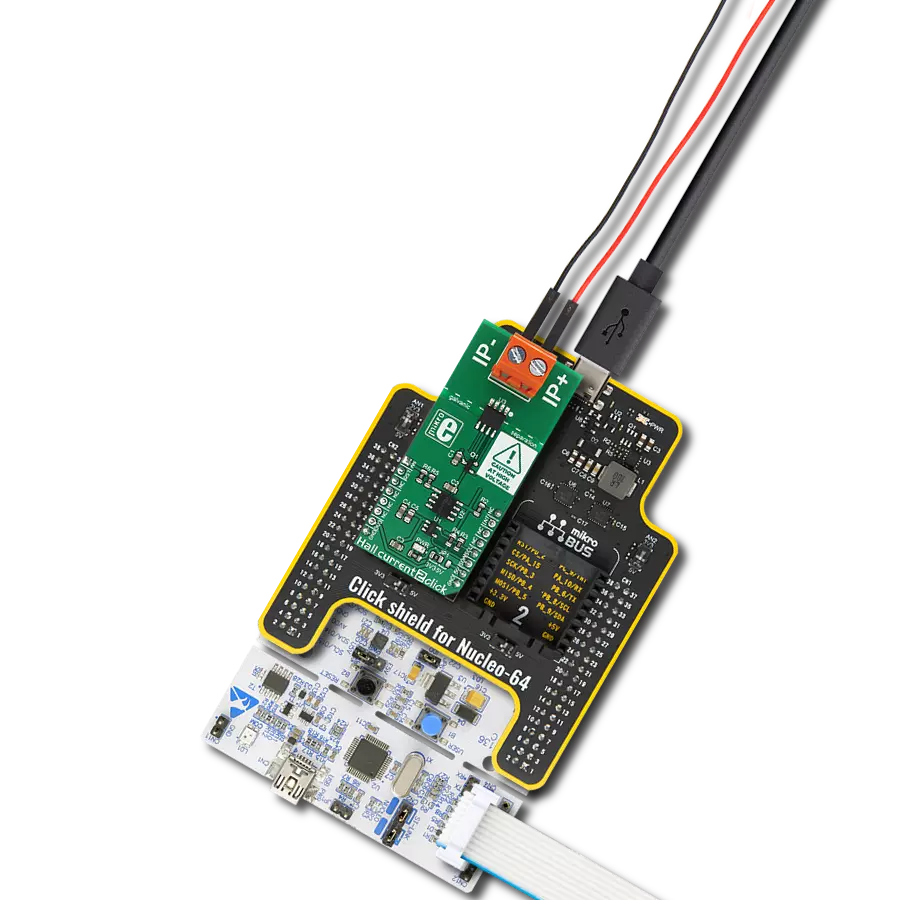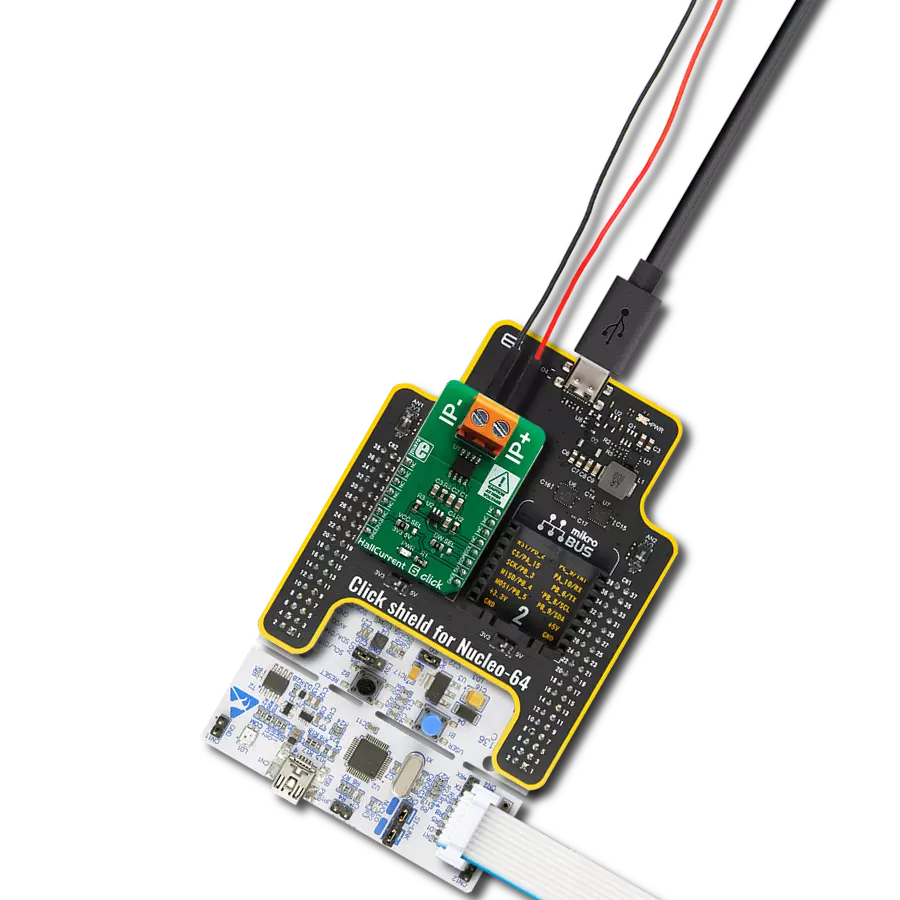Precise monitoring and control of both AC and DC currents, suitable for a wide range of applications where accurate current measurement and safety are crucial
A
A
Hardware Overview
How does it work?
Current Sens 2 Click is based on the HO 10-P, an AC/DC current transducer from LEM USA. The HO 10-P is well-known for measuring DC, AC, and pulse currents up to 10ARMS with galvanic isolation between the primary and secondary circuits. With its core built on the open-loop Hall effect measuring principle, the Current Sens 2 Click ensures precise and reliable current measurements. Its capability covers a variety of industrial applications, including AC variable speed drives, UPS systems, SMPS, and power supplies for welding, which benefit from low power consumption and high immunity to external interference. The device's fast response time suits dynamic and demanding environments. The HO 10-P is designed for through-hole PCB mounting and features a sizable aperture (8x8mm) for the primary
conductor, ensuring easy integration and versatility. Although the sensor can measure current up to 10A, its sensitivity can be altered in three specific scenarios. When current is applied to the input, for instance, pin 6, and the output is obtained from pin 11, the sensor's sensitivity becomes x1. This configuration is considered as the wire being wound only once around the sensor's core, marking the first scenario. In another configuration, short-circuiting pins 7 and 10 while keeping the input and output on pins 6 and 11 doubles the sensitivity (x2). Similarly, sensitivity triples (x3) when pins 7-10 and 8-9 are short-circuited, maintaining the input and output on pins 6 and 11. Maintaining a straight signal path from the input to the output is crucial, as depicted in the schematic (6-11, 7-10, 8-9). It's also possible to measure the conductor's current by
pulling it through the sensor's core and allowing current to flow through it. The sensor is powered by the 5V mikroBUS™ power rail and outputs the sensed current as an analog signal through the AN pin. Additionally, an orange LED and a dedicated pin (OCD) on the mikroBUS™ socket signal an overcurrent condition, providing enhanced safety and monitoring features. This Click board™ can operate with either 3.3V or 5V logic voltage levels selected via the VCC SEL jumper. This way, both 3.3V and 5V capable MCUs can use the communication lines properly. Also, this Click board™ comes equipped with a library containing easy-to-use functions and an example code that can be used as a reference for further development.

Features overview
Development board
Clicker 4 for STM32F4 is a compact development board designed as a complete solution that you can use to quickly build your own gadgets with unique functionalities. Featuring an STM32F407VGT6 MCU, four mikroBUS™ sockets for Click boards™ connectivity, power management, and more, it represents a perfect solution for the rapid development of many different types of applications. At its core is an STM32F407VGT6 MCU, a powerful microcontroller by STMicroelectronics based on the high-performance
Arm® Cortex®-M4 32-bit processor core operating at up to 168 MHz frequency. It provides sufficient processing power for the most demanding tasks, allowing Clicker 4 to adapt to any specific application requirements. Besides two 1x20 pin headers, four improved mikroBUS™ sockets represent the most distinctive connectivity feature, allowing access to a huge base of Click boards™, growing on a daily basis. Each section of Clicker 4 is clearly marked, offering an intuitive and clean interface. This makes working with the
development board much simpler and, thus, faster. The usability of Clicker 4 doesn’t end with its ability to accelerate the prototyping and application development stages: it is designed as a complete solution that can be implemented directly into any project, with no additional hardware modifications required. Four mounting holes [4.2mm/0.165”] at all four corners allow simple installation by using mounting screws.
Microcontroller Overview
MCU Card / MCU

Architecture
ARM Cortex-M4
MCU Memory (KB)
10
Silicon Vendor
STMicroelectronics
Pin count
100
RAM (Bytes)
100
Used MCU Pins
mikroBUS™ mapper
Take a closer look
Click board™ Schematic

Step by step
Project assembly
Software Support
Library Description
This library contains API for Current Sens 2 Click driver.
Key functions:
currentsens2_get_int_pin- Current Sens 2 get int pin state functioncurrentsens2_tare- Current Sens 2 tare functioncurrentsens2_get_current- Current Sens 2 read current function
Open Source
Code example
The complete application code and a ready-to-use project are available through the NECTO Studio Package Manager for direct installation in the NECTO Studio. The application code can also be found on the MIKROE GitHub account.
/*!
* @file main.c
* @brief Current Sens 2 Click Example.
*
* # Description
* This example demonstrates the use of Current Sens 2 Click board by reading and
* displaying the input current measurements.
*
* The demo application is composed of two sections :
*
* ## Application Init
* Initializes the driver and logger.
*
* ## Application Task
* Reads the input current measurements and displays the results on the USB UART
* approximately once per second.
*
* @author Stefan Ilic
*
*/
#include "board.h"
#include "log.h"
#include "currentsens2.h"
static currentsens2_t currentsens2; /**< Current Sens 2 Click driver object. */
static log_t logger; /**< Logger object. */
void application_init ( void )
{
log_cfg_t log_cfg; /**< Logger config object. */
currentsens2_cfg_t currentsens2_cfg; /**< Click config object. */
/**
* Logger initialization.
* Default baud rate: 115200
* Default log level: LOG_LEVEL_DEBUG
* @note If USB_UART_RX and USB_UART_TX
* are defined as HAL_PIN_NC, you will
* need to define them manually for log to work.
* See @b LOG_MAP_USB_UART macro definition for detailed explanation.
*/
LOG_MAP_USB_UART( log_cfg );
log_init( &logger, &log_cfg );
log_info( &logger, " Application Init " );
// Click initialization.
currentsens2_cfg_setup( ¤tsens2_cfg );
CURRENTSENS2_MAP_MIKROBUS( currentsens2_cfg, MIKROBUS_1 );
if ( ADC_ERROR == currentsens2_init( ¤tsens2, ¤tsens2_cfg ) )
{
log_error( &logger, " Communication init." );
for ( ; ; );
}
log_printf( &logger, " Remove Click from the electrical circuit \r\n" );
Delay_ms ( 1000 );
if ( CURRENTSENS2_ERROR == currentsens2_tare ( ¤tsens2 ) )
{
log_error( &logger, " Click tare error." );
for ( ; ; );
}
currentsens2_set_prim_turn_no( ¤tsens2, CURRENTSENS2_NUM_OF_PASSES_1 );
log_printf( &logger, " Connect Click to the electrical circuit \r\n" );
log_info( &logger, " Application Task " );
}
void application_task ( void )
{
float current = 0;
if ( CURRENTSENS2_OK == currentsens2_get_current ( ¤tsens2, ¤t ) )
{
log_printf( &logger, " Current : %.2f[A]\r\n\n", current );
Delay_ms ( 1000 );
}
}
int main ( void )
{
/* Do not remove this line or clock might not be set correctly. */
#ifdef PREINIT_SUPPORTED
preinit();
#endif
application_init( );
for ( ; ; )
{
application_task( );
}
return 0;
}
// ------------------------------------------------------------------------ END
Additional Support
Resources
Category:Current sensor
































